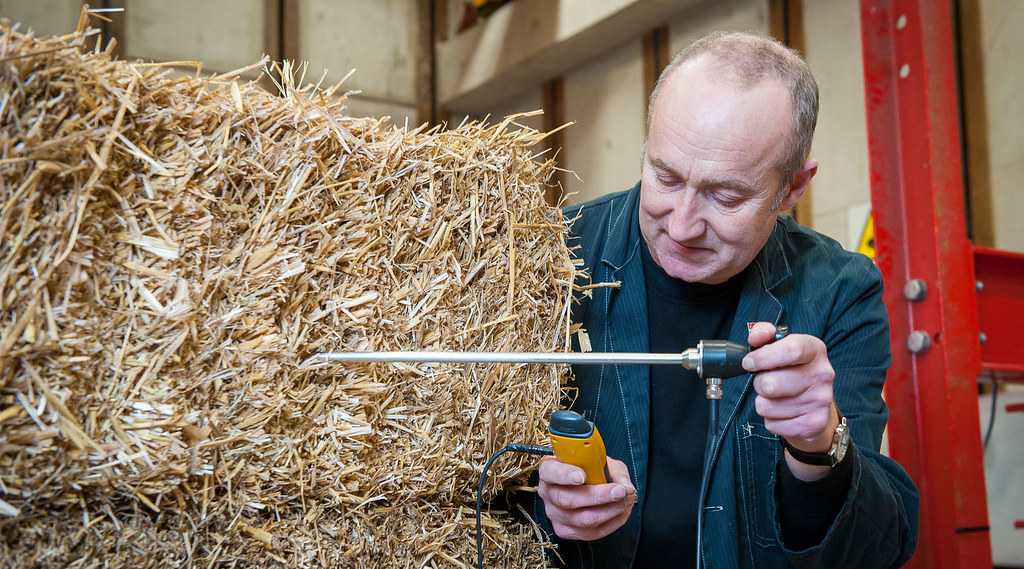Many technologies have promised these qualities, but few have been commercially viable. What's been lacking is the performance data needed to demonstrate that these technologies are durable, genuinely environmentally beneficial, and suitable to be insured.
Over the past 13 years, our Department of Architecture & Civil Engineering has led on research into straw as a low-impact building material. This work, which has included developing a unique straw bale panel as well as scientific monitoring and testing, has now culminated in crucial industry certifications.
The BM TRADA’s Q-Mark certification guarantees a straw building’s energy efficiency, fire safety, durability and weather-resilience and means that developers and homebuyers can now get insurance and mortgages for straw homes and buildings.
The prestigious Passivhaus accreditation recognises a building design’s energy efficiency, high-performance insulation and air quality.
Huge energy savings for residents
In Shirehampton, Bristol, seven new straw townhouses have just gone on sale in the open market.
The innovative straw walls in the new houses provide two times more insulation than required by current UK building regulations. Based on monitoring a residential straw-bale development in Leeds, fuel bill reductions up to 90% can be expected.
The walls have been built using ModCell technology; prefabricated panels consisting of a wooden structural frame infilled with straw bales or hemp and rendered with either a breathable lime-based system or ventilated timber or brick cladding.
This technology combines the lowest carbon footprint and the best operational CO² performance of any system of construction currently available. In fact, as an agricultural co-product, straw buildings can be carbon negative as straw absorbs CO² when it grows.
Decade of data to scientifically back straw
Our journey into straw building began over a decade ago when researchers in our Department of Architecture & Civil Engineering started developing an understanding of the load-bearing capabilities of straw.
In 2005, the research group, led by Pete Walker, Head of the Department of Architecture & Civil Engineering, began a collaboration with ModCell Ltd to develop prefabricated straw bale cladding panels. This led to government and EU funding (EASME) to investigate structural and durability aspects of straw and the potential to upscale and make it cost effective in construction.
To test durability, energy usage and moisture content in situ, the team built a prototype — ‘BaleHaus’ — on our campus. The building captured the imaginations of staff and students, making the research behind it one of the most talked-about projects on campus.
They carried out weatherproof testing in a very exposed site on the blustery Cornish coast as well as in the lab. The ModCell panels have been blasted by simulated hurricane-force wind loads, soaked in water to simulate flooding and exposed to roaring fires.
To get data on residential energy consumption, the team monitored the LILAC co-housing development in Leeds with 20 ModCell homes — and discovered a reduction in energy usage of up to 90%.
Internationally-recognised research
In 2014, the research culminated in the sought-after industry certificate, which provided the construction sector with scientific proof that straw is durable, genuinely environmentally beneficial and suitable to be insured.
In the independently-assessed 2014 Research Excellence Framework, we ranked first in the UK for Architecture, Built Environment and Planning. Of all our submitted research in this discipline, which the BaleHaus project formed part of, 90% was classified as world-leading or internationally excellent.
For ModCell, collaboration with our researchers has been equally beneficial. The company has grown from £11k in 2008 to £1.8m in 2012, and has employed an additional nine full-time staff in that period.
Craig White, the director of ModCell, said that the research carried out at the University of Bath has been 'instrumental in the growth of ModCell'.
Community impact
The potential of straw-bale construction extends beyond residential buildings and is already proving to have a positive impact in local communities.
In 2012, Hayesfield School in Bath opened a new science block for its students, The Nucleus. In the building, ModCell technology doubles as a building material and as a teaching aid — students have first-hand access to learn about the properties of straw as a material.
The Nucleus uses straw panels also as a roof and is currently being monitored so we can continue to learn about the efficiency of ModCell panels.
All the materials used in ModCell panels — straw, lime and timber — can be locally sourced. The overall carbon footprint is further reduced by minimising logistics — all panels are put together within 15 miles of the construction site at mobile factories.
Future of sustainable housing
Research into innovative and sustainable building forms an integral part of the activities of our Department of Architecture & Civil Engineering.
Last year, the University opened a Building Research Park in Swindon to provide a place for construction companies and academics to test low carbon construction materials and systems in realistic open-air conditions.
The park includes a £1 million ground-breaking building project, The HIVE, which offers a ‘plug and play’ facility and expertise for testing and evaluating. The HIVE is the first facility of its kind in the UK.
The Department also has a dedicated research centre leading research into potential solutions to the environmental impacts of construction and infrastructure.
Through its research, BRE Centre for Innovative Construction Materials is working towards reducing the UK’s eco footprint and help mitigate the projected doubling of cement-based CO² emissions by 2050.
Professor Pete Walker believes straw is up to the challenge. 'The construction sector must reduce its energy consumption by 50% and its carbon emissions by 80% by 2050, so radical changes are needed to the way we approach house building', he said.
'As a construction material, straw is a low-cost and widely available food co-product that offers real potential for ultra-low carbon housing throughout the UK. Building with straw could be a critical point in our trajectory towards a low-carbon future.'
